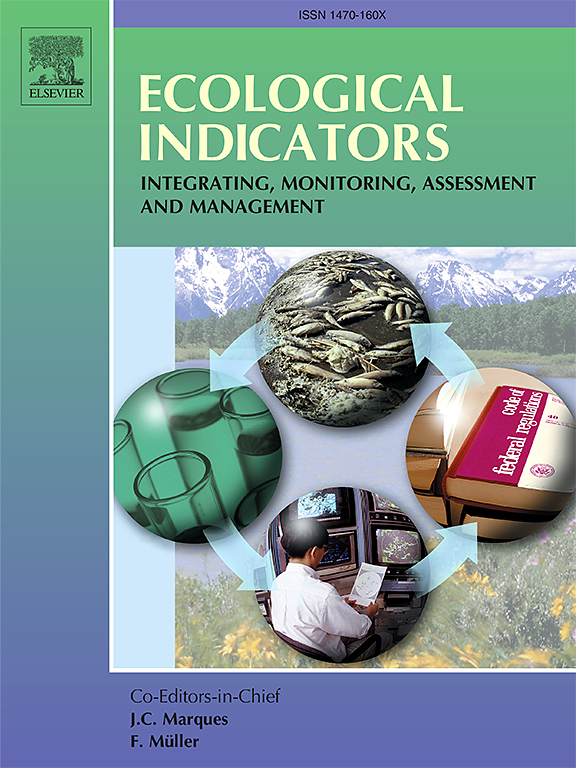基于文献计量学的能值研究现状及热点分析
IF 7
2区 环境科学与生态学
Q1 ENVIRONMENTAL SCIENCES
引用次数: 0
摘要
能值理论和方法在生态系统和可持续性研究中得到了广泛的应用。本文采用文献计量学方法和可视化工具(SATI、VOSviewer和CiteSpace)对Web of Science数据库中检索到的1404篇能源相关文章进行了系统的统计分析。结果表明:1)总体上,年出版量呈现持续上升的趋势。中国在国家、机构和个人的各个层面上都有突出的贡献。2)能能类论文主要发表在高质量期刊上,主要集中在环境和生态科学领域,特别是生态系统、地球生物圈、可持续发展和可持续性评价等领域。3)在人口快速增长和气候变化的背景下,能值理论在可持续发展领域得到了应用和发展。能值研究不仅探索减少人类活动对气候变化影响的途径,而且结合多种理论方法为决策者提供定量工具,促进新兴技术系统的可持续评价。这些主题预计仍将是能源研究的重点。此外,能源与人工智能(AI)等新兴领域的整合显示出巨大的潜力。4)能源研究仍面临方法论争议、数据依赖、动态建模能力不足等问题。我们迫切需要通过建立标准化的方法框架、开发人工智能集成的动态模型、促进跨学科/跨国合作、推进文献计量学和元分析的交叉应用来应对这些挑战。本文章由计算机程序翻译,如有差异,请以英文原文为准。
Analysis of the current status and hotspots of emergy research based on bibliometrics
Emergy theory and methodology have been widely applied in the study of ecosystems and sustainability. This article employs bibliometric methods and visualization tools (SATI, VOSviewer and CiteSpace) to conduct a systematic statistical analysis of 1,404 emergy-related articles retrieved from the Web of Science database. The results are as follows: 1) Overall, the annual publication volume demonstrates a consistent upward trajectory. China exhibits dominant contributions across all levels—national, institutional, and individual authorship. 2) Emergy-related papers are mainly published in high - quality journals, concentrated in environmental and ecological sciences, especially in themes related to ecosystems, the geobiosphere, sustainable development, and sustainability assessment. 3) Against the backdrop of rapid population growth and climate change, emergy theory has been applied and developed in the field of sustainable development. Emergy research not only explores ways to reduce the impact of human activities on climate change but also provides quantitative tools for decision-makers in combination with a variety of theoretical approaches to promote sustainable evaluation of emerging technology systems. These themes are expected to remain key focuses in emergy research. Additionally, the integration of emergy with emerging fields such as Artificial Intelligence (AI) shows great potential. 4) Emergy research still faces issues like methodological disputes, data dependency, and insufficient dynamic modeling capabilities. There’s an urgent need to address these challenges, by establishing a standardized methodological framework, developing AI-integrated dynamic models, promoting cross-disciplinary/cross-national cooperation, and advancing the cross-application of bibliometrics and meta-analysis.
求助全文
通过发布文献求助,成功后即可免费获取论文全文。
去求助
来源期刊

Ecological Indicators
环境科学-环境科学
CiteScore
11.80
自引率
8.70%
发文量
1163
审稿时长
78 days
期刊介绍:
The ultimate aim of Ecological Indicators is to integrate the monitoring and assessment of ecological and environmental indicators with management practices. The journal provides a forum for the discussion of the applied scientific development and review of traditional indicator approaches as well as for theoretical, modelling and quantitative applications such as index development. Research into the following areas will be published.
• All aspects of ecological and environmental indicators and indices.
• New indicators, and new approaches and methods for indicator development, testing and use.
• Development and modelling of indices, e.g. application of indicator suites across multiple scales and resources.
• Analysis and research of resource, system- and scale-specific indicators.
• Methods for integration of social and other valuation metrics for the production of scientifically rigorous and politically-relevant assessments using indicator-based monitoring and assessment programs.
• How research indicators can be transformed into direct application for management purposes.
• Broader assessment objectives and methods, e.g. biodiversity, biological integrity, and sustainability, through the use of indicators.
• Resource-specific indicators such as landscape, agroecosystems, forests, wetlands, etc.
 求助内容:
求助内容: 应助结果提醒方式:
应助结果提醒方式:


